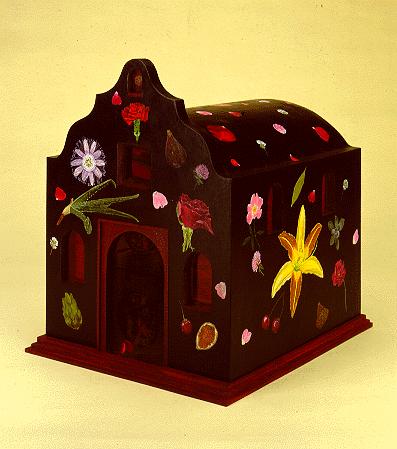 This is a sculpture I made in 1987 about St. Teresa of Avila and my feelings about her. It is made
of laminated foamcore and cardboard, lined with copper sheet, and painted. It is bigger than a
breadbox.
This is a sculpture I made in 1987 about St. Teresa of Avila and my feelings about her. It is made
of laminated foamcore and cardboard, lined with copper sheet, and painted. It is bigger than a
breadbox. The piece began with the form of a church, like the Spanish missions in California, where I'm from. The black is meant to suggest the severity of a nun's habit, but I also find black beautiful. The rose petals painted on top I imagined falling from the sky. The roses and rose petals painted on it are traditional symbols of sainthood. The clovers represent humility - a quality I believe St. Teresa had, though there have been others, from her own time until today who would not agree. The clovers, like many of the other flowers on it were painted from ones I gathered from around where I was living in rural Georgia, near Lake Lanier. At the time, it felt important for me to use things that were growing around me.
Passion flowers - for the passion of Christ, something that St. Teresa regularly meditated on - are called "May pops" in Georgia, and grew twining on the fence posts of the cattle pastures. An old farmer who lived in my neighborhood saw me gathering clovers and day lilies. From that day on, every morning when I woke up I found my front porch loaded with piles of day lilies from his garden, still covered with dew.
The bird of paradise is the official flower of my native city, Los Angeles, El Pueblo de Nuestra Señora de los Angeles de la Portiuncula - the City of Our Lady of the Angels of the Portiuncula. The Portiuncula was an abandoned church renovated by St. Francis of Assisi when he became a monk and created his original brotherhood. St. Francis believed that monks and nuns should live in holy poverty, a highly controversial idea that caused scandal in his century just as St. Teresa's reforms caused scandal in hers. St. Teresa had a vision in which St. Francis's colleague and friend, St. Clare, blessed her undertaking.
 The inside of the sculpture is lined with copper. When you put your hand inside it you can feel its
radiated warmth. I wanted the inside to be warm like a womb. It has red glass windows and when
natural light interacts with it during the day, it changes. It sometimes gets a deep ruby red inside.
At the back, there's a pomegranate, a biblical symbol of female sexuality, as are the open figs on the
outside.
The inside of the sculpture is lined with copper. When you put your hand inside it you can feel its
radiated warmth. I wanted the inside to be warm like a womb. It has red glass windows and when
natural light interacts with it during the day, it changes. It sometimes gets a deep ruby red inside.
At the back, there's a pomegranate, a biblical symbol of female sexuality, as are the open figs on the
outside.
Mixing symbols of sainthood and femininity has a lot to do with my ambivalent feelings about what it is to be a woman in the world. There are also prickly things which I think have something to do with it too: the artichoke and the aloe are prickly on the outside but soft, wholesome and healing on the inside.
I have used this sculpture in my work in the area of executive education to talk about St. Teresa and leadership for several years now. Over that time, I've noticed the story changing, as I change, and as my relationship to St. Teresa changes. When I had my 40th birthday, it occurred to me for the first time that, like St. Teresa, I spent the first half of my life in isolation. She spent it in the convent (La Encarnación, in Avila) where she had her most dramatic mystical experiences; I spent it in the studio, focused on making art, which itself can sometimes feel like mystical experience. In the second half of her life, St. Teresa went out into the world and founded the convents of her Reform, and she wrote the books that still bring her recognition as a great theologian and teacher. In the second half of my life, I want to go out into the world, to teach, to talk with people, to have an influence and create real things in the world of business and politics.
Photos by Susan Segal
Back Home
 Saint Teresa's House
Saint Teresa's House